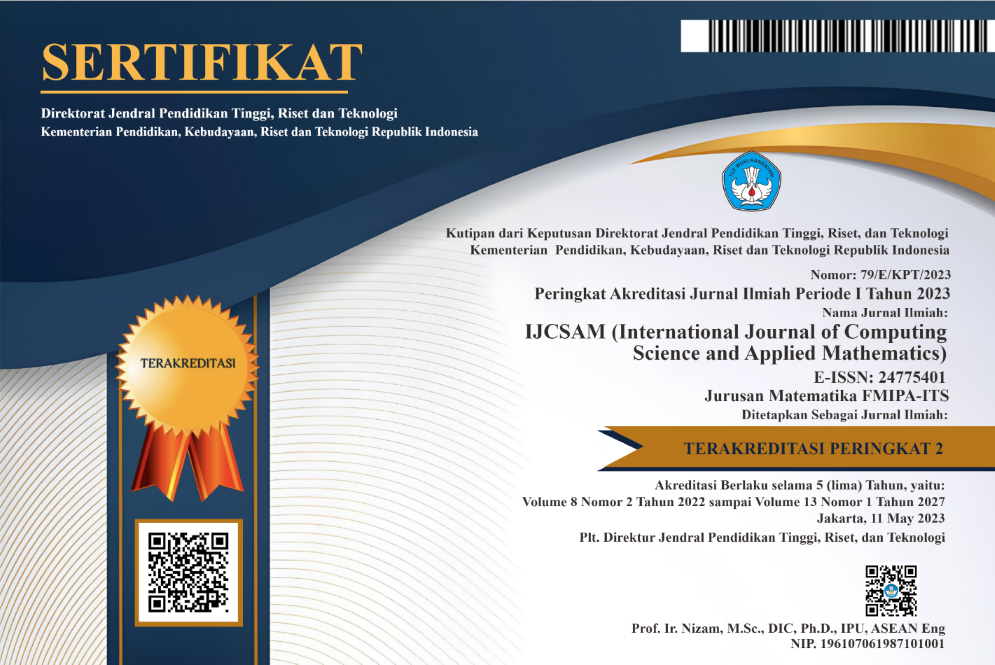Digital Option Pricing Approach Using A Homotopy Perturbation Method
Abstract
Keywords
Full Text:
PDFReferences
F. Black and M. Scholes, “The pricing of options and corporate liabilities,” in World Scientific Reference on Contingent Claims Analysis in Corporate Finance: Volume 1: Foundations of CCA and Equity Valuation, 2019, pp. 3–21.
L. Mardianto, A. Pratama, A. Soemarsono, A. Hakam, and E. Putri, “Comparison of numerical methods on pricing of european put options,” IJCSAM (International Journal of Computing Science and Applied Mathematics), vol. 5, no. 1, pp. 30–34, 2019.
Z. Cen and A. Le, “A robust and accurate finite difference method for a generalized black–scholes equation,” Journal of Computational and Applied Mathematics, vol. 235, no. 13, pp. 3728–3733, 2011.
P. Boyle, “Options: A monte carlo approach,” Journal of financial economics, vol. 4, no. 3, pp. 323–338, 1977.
R. Mohammadi, “Quintic b-spline collocation approach for solving generalized black–scholes equation governing option pricing,” Computers & Mathematics with Applications, vol. 69, no. 8, pp. 777–797, 2015.
S. Rodriguez and F. Marin, “European call option pricing by the adomian decomposition method,” Advances in Dynamical Systems and Applications, vol. 9, no. 1, pp. 75–85, 2011.
Z. Ke, J. Goard, and S.-P. Zhu, “An appropriate approach to pricing european-style options with the adomian decomposition method,” The ANZIAM Journal, vol. 59, no. 3, pp. 349–369, 2018.
E. Putri, L. Mardianto, A. Hakam, C. Imron, and H. Susanto, “Removing non-smoothness in solving black-scholes equation using a perturbation method,” Physics Letters A, vol. 402, p. 127367, 2021.
J.-H. He, “Homotopy perturbation method: a new nonlinear analytical technique,” Applied Mathematics and computation, vol. 135, no. 1, pp. 73–79, 2003.
V. G¨ulkac¸, “The homotopy perturbation method for the black–scholes equation,” Journal of Statistical Computation and Simulation, vol. 80, no. 12, pp. 1349–1354, 2010.
Z. Ayati and J. Biazar, “On the convergence of homotopy perturbation method,” Journal of the Egyptian Mathematical society, vol. 23, no. 2, pp. 424–428, 2015.
J. Biazar and H. Aminikhah, “Study of convergence of homotopy perturbation method for systems of partial differential equations,” Computers & Mathematics with Applications, vol. 58, no. 11-12, pp. 2221–2230, 2009.
P. Wilmott, S. Howison, and J. Dewynne, The mathematics of financial derivatives: a student introduction. Cambridge university press, 1995.
DOI: http://dx.doi.org/10.12962%2Fj24775401.v7i2.9776
Refbacks
- There are currently no refbacks.
View My Stats

International Journal of Computing Science and Applied Mathematics by Pusat Publikasi Ilmiah LPPM, Institut Teknologi Sepuluh Nopember is licensed under a Creative Commons Attribution-ShareAlike 4.0 International License.
Based on a work at https://iptek.its.ac.id/index.php/ijcsam.






